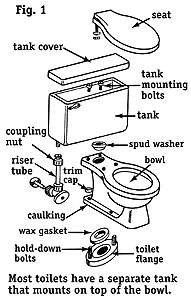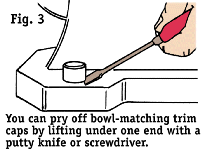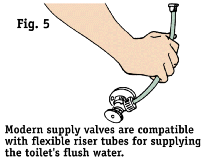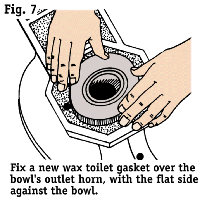|
|
 |
|
 |
|
|
 |
|
 |
Changing your toilet is an easy project that should take half a day or less. The most common toilet has a separate tank that mounts on top of the bowl. These instructions apply most specifically to this type of toilet. If you have an integral tank/bowl toilet, a flush valve or a wall-mounted toilet, your procedure will vary somewhat.
Whatever kind of toilet you use as a replacement, follow the manufacturer's instructions. Fig. 1 shows the parts of the a typical toilet.

|
 PREPARATION FOR THE REPLACEMENT
|

|
 REMOVING THE OLD TOILET
|

|
 PREPARING TO INSTALL THE NEW TOILET
|

|
 PUTTING IN THE NEW BOWL
|

|
 INSTALLING THE TANK
|
 FINISHING UP
FINISHING UP
| Toilet Bowl and Tank | Toilet Seat | Bowl Gasket | Hold-Down Bolts, Washers, Nuts | Trim Caps (if not with toilet) | |
| Plumber's Putty | Bathtub Caulk/Sealant | Supply Valve | Flat-Ended Riser Tube | Adjustable Open-End Wrenches | |
| Trap Wrench/Water Pump Pliers | Large Screwdriver | Mini-Hacksaw | Sponge | Rustproof Washers | |
Check your state and local codes before starting any project. Follow all safety precautions. Information in this on-line brochure has been furnished by the National Retail Hardware Association. Every effort has been made to ensure accuracy and safety. Neither the NRHA nor the retailer can be held responsible for damages or injuries resulting from the use of the information in this document.